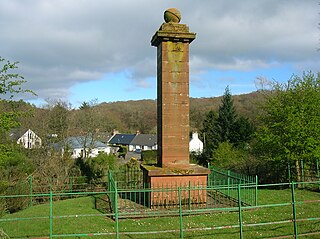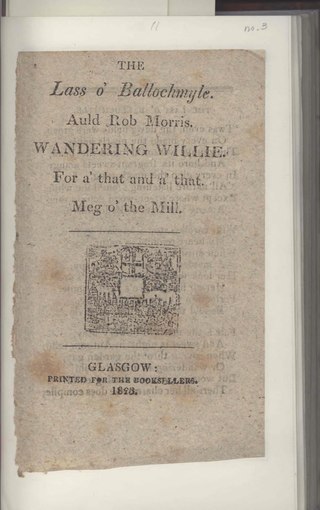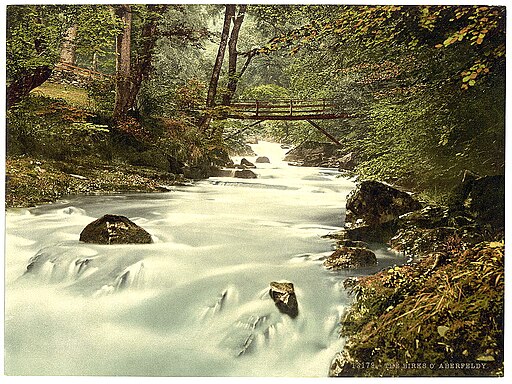
Bonnie Dundee is the title of a poem and a song written by Walter Scott in 1825 in honour of John Graham, 7th Laird of Claverhouse, who was created 1st Viscount Dundee in November 1688, then in 1689 led a Jacobite rising in which he died, becoming a Jacobite hero.

Robert Tannahill was a Scottish poet of labouring class origin. Known as the 'Weaver Poet', he wrote poetry in English and lyrics in Scots in the wake of Robert Burns.

Aberfeldy is a burgh in Perth and Kinross, Scotland, on the River Tay. A small market town, Aberfeldy is located in Highland Perthshire. It was mentioned by Robert Burns in the poem The Birks Of Aberfeldy and in the Ed Sheeran song The Hills of Aberfeldy.
"Highland Laddie", also known as "Hielan' Laddie", is the name of a Scottish popular folk tune "If Thou'lt Play Me Fair Play", but as with many old melodies various sets of words can be sung to it, of which Robert Burns's poem "Highland Laddie" is probably the best known. "If Thou'lt Play Me Fair Play" has been reworked several times since Burns set down his words, Donkey Riding being one variant.

"Tam o' Shanter" is a narrative poem written by the Scottish poet Robert Burns in 1790, while living in Dumfries. First published in 1791, at 228 lines it is one of Burns' longer poems, and employs a mixture of Scots and English.
"Annie Laurie" is an old Scottish song based on a poem said to have been written by William Douglas of Dumfriesshire, about his romance with Annie Laurie (1682–1764). The words were modified and the tune was added by Alicia Scott in 1834/5. The song is also known as "Maxwelton Braes".
The Bonnie Lass o' Fyvie is a Scottish folk song about a thwarted romance between a soldier and a girl. Like many folk songs, the authorship is unattributed, there is no strict version of the lyrics, and it is often referred to by its opening line "There once was a troop o' Irish dragoons". The song is also known by a variety of other names, the most common of them being "Peggy-O", "Fennario", and "The Maid of Fife".

"The Bonnie Banks o' Loch Lomond", or "Loch Lomond" for short, is a Scottish song. The song prominently features Loch Lomond, the largest Scottish loch, located between the council areas of West Dunbartonshire, Stirling and Argyll and Bute. In Scots, "bonnie" means "attractive", "beloved", or "dear".

Sings the Songs of Robert Burns is the seventh studio album by Eddi Reader. It was released in the UK on 12 May 2003.
"Wild Mountain Thyme" is a Scottish/Irish folk song. The lyrics and melody are a variant of the song "The Braes of Balquhither" by Scottish poet Robert Tannahill (1774–1810) and Scottish composer Robert Archibald Smith (1780–1829), but were adapted by Belfast musician Francis McPeake (1885–1971) into "Wild Mountain Thyme" and first recorded by his family in the 1950s.

Duncan MacGregor Crerar was a Scottish poet who spent much of his adult life in western Ontario and New York City, writing sentimental poetry commemorating places and friends in Scotland. A native Gaelic speaker, he wrote primarily in English, with Gaelic phrases and diction. He was referred to by some contemporaries as "The Breadalbane Bard" or "Bard of Amulree". In his book Scottish Poets in America, John D. Ross described him:
In conclusion, we would state that Mr. Crerar is one of the most genial of men, kind, sympathetic, and generous in all his actions. In his own quiet, unobtrusive way, and unknown to the world, he has rendered assistance to many when they found the clouds of adversity hovering over them: and there are few men similarly circumstance who can boast of so large and so sincere a following of friends.
The (Bonnie) Rantin' Laddie or Lord Aboyne is a traditional Scottish folk ballad telling of the valiant rescue of his lover by a noble Highland lord.

Parcel of Rogues is the fifth studio album by English folk rock group Steeleye Span. It was released in 1973 by Chrysalis Records. The album was their most successful album thus far, breaking into the Top 30.

Highland Mary is a song composed in 1792 by Scottish poet Robert Burns. It is one of three works dedicated to Mary Campbell, with whom Burns was in love in the 1780s. The others, "Highland Lassie, O" and "Will Ye Go to the Indies My Mary?", were composed in 1786. "Highland Mary" consists of four stanzas that speak of Burns's affection for the lady, his melancholy at her death and his continued memory of her. The melody was that of "Katherine Ogie."

Mary Campbell, also known as Highland Mary, was the daughter of Archibald Campbell of Daling, a sailor in a revenue cutter, whose wife was Agnes Campbell of Achnamore or Auchamore. Mary was the eldest of a family of four. Robert Burns had an affair with her after he felt that he had been "deserted" by Jean Armour following her move to Paisley in March 1786. The brief affair started in April 1786, and the parting took place on 14 May of that year. Mary's pronunciation of English was heavily accented with the lilt of local indigenous language, Gaelic - and this led to her becoming known as 'Highland Mary.'
"The Banks o' Doon" is a Scots song written by Robert Burns in 1791, sometimes known as "Ye Banks and Braes". Burns set the lyrics to an air called The Caledonian Hunt's Delight. Its melodic schema was also used for Phule Phule Dhole Dhole, a song by Bengali poet Rabindranath Tagore.

Wilhelmina Alexander (1756–1843), was born at Newton House, Elderslie, Renfrewshire. She was the 4th daughter of Claud Alexander of Newton and Joanna, daughter of Alexander Cuninghame of Craigends. Her lasting fame derives from being Robert Burns's 'The Bonnie Lass o'Ballochmyle' in the song of that title. Robert Burns was accustomed to taking walks and musing over his poetry and songs in the Ballochmyle Estate next to the River Ayr when he caught sight of her one-day and composed the song in memory of the event. She refused publication at the time and Burns never forgave this perceived slight on his genius, Wilhelmina never married, she did however treasure the letter and the manuscript of the song until her dying day.

'Robert Burns's Interleaved Scots Musical Museum' or the 'Interleaved Glenriddell Manuscript' is a set of four octavo volumes of James Johnson's The Scots Musical Museum in which Robert Burns provided additional material to the original publication on interleaved sheets and which he eventually gifted to Captain Robert Riddell (1755–94) of Friars Carse, Dumfries and Galloway, Scotland.
Jean Lorimer (1775–1831) was a friend of the poet Robert Burns, often referred to by him as the "Lassie wi' the lint-white locks" or "Chloris". Lorimer was born at Craigieburn House on a small estate near Moffat and from 1788 to 1791 was a neighbour of Burns when he was living at Ellisland Farm, her father's new farm being at Kemmishall or Kemys Hall, Kirkmahoe Parish, two miles to the south of Ellisland on the opposite bank of the Nith. Burns commented "The Lady on whom it was made, is one of the finest women in Scotland" in a letter to George Thomson, enclosing one of the two dozen or so songs that he wrote for her. They first met when she was a teenager through his excise duties bringing him to their farm.















